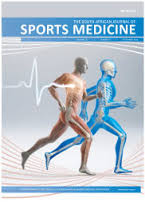The point prevalence of South African male soccer players’ injuries in the Gauteng province
DOI:
https://doi.org/10.17159/2078-516X/2024/v36i1a17653Abstract
Background: The ever-evolving game of soccer is a complex physical contact team sport, exposing its participants to injury.
Objectives: To identify the point prevalence of soccer injuries among young amateur, semi-professional, and professional South African male soccer players.
Methods: The participation of male amateur (n=54), semi-professional (n=34), and professional (n=57) players provided a cross-sectional overview of the nature of the most predominant types and anatomical sites of injuries affecting soccer players (average age 23.9±4.7 years). All participants completed the Fuller soccer injury questionnaire, ISAK somatotype profiling and knee flexion/extension isokinetic concentric peak torque (Nm) evaluations at 60°/s.
Results: Fifty per cent of the players sustained soccer injuries (X2=0.9). Knee (20%) and ankle (19%) were the most vulnerable sites (X2=0.00001). Knee-injured players’ right quadriceps torque (199±37 vs 223±38 Nm) and percentage right quadriceps torque relative to body mass (286±54 vs 311 ±39%) was significantly weaker than the non-injured players (p<0.01). The injured players’ right hamstrings/quadriceps (H/Q) torque ratio further significantly differed from the non-injured players’ H/Q torque ratios (79±17 vs 70±9%) (p<0.01).
Conclusion: Male soccer players experience neuro-musculoskeletal injuries, with their knees and ankles being the most vulnerable. Knee-injured players had weaker quadriceps isokinetic strength than non-injured players.
Downloads
Downloads
Published
Issue
Section
License
Copyright (c) 2024 South African Journal of Sports Medicine

This work is licensed under a Creative Commons Attribution 4.0 International License.
The South African Journal of Sports Medicine reserves copyright of the material published. The work is licensed under a Creative Commons Attribution 4.0 (CC BY 4.0) International License. Material submitted for publication in the South African Journal of Sports Medicine is accepted provided it has not been published elsewhere. The South African Journal of Sports Medicine does not hold itself responsible for statements made by the authors.
How to Cite
- Abstract 271
- PDF 220






.png)